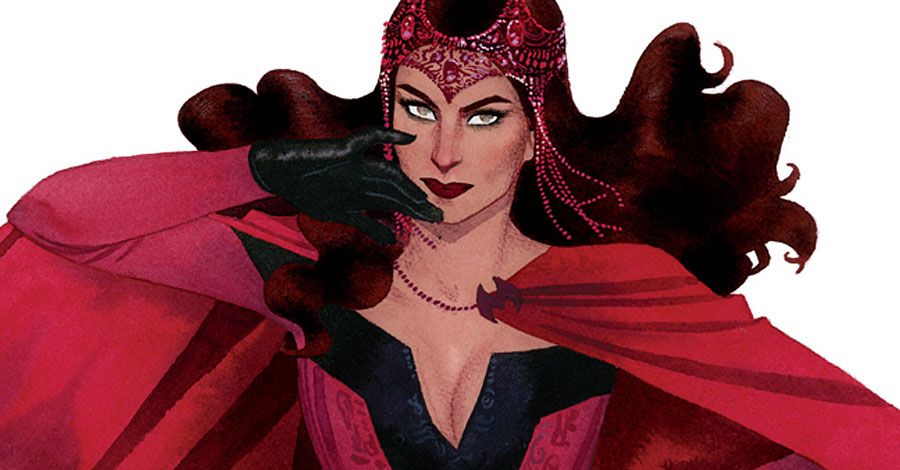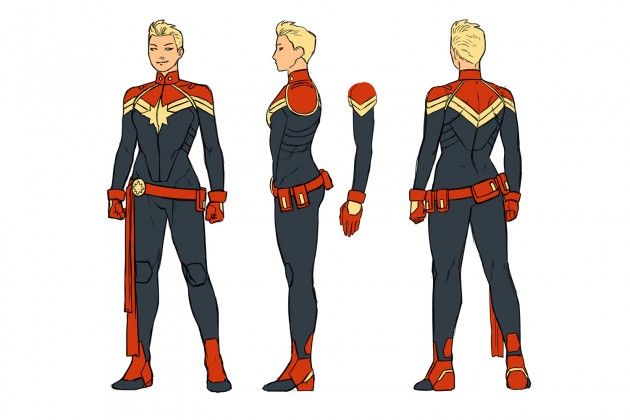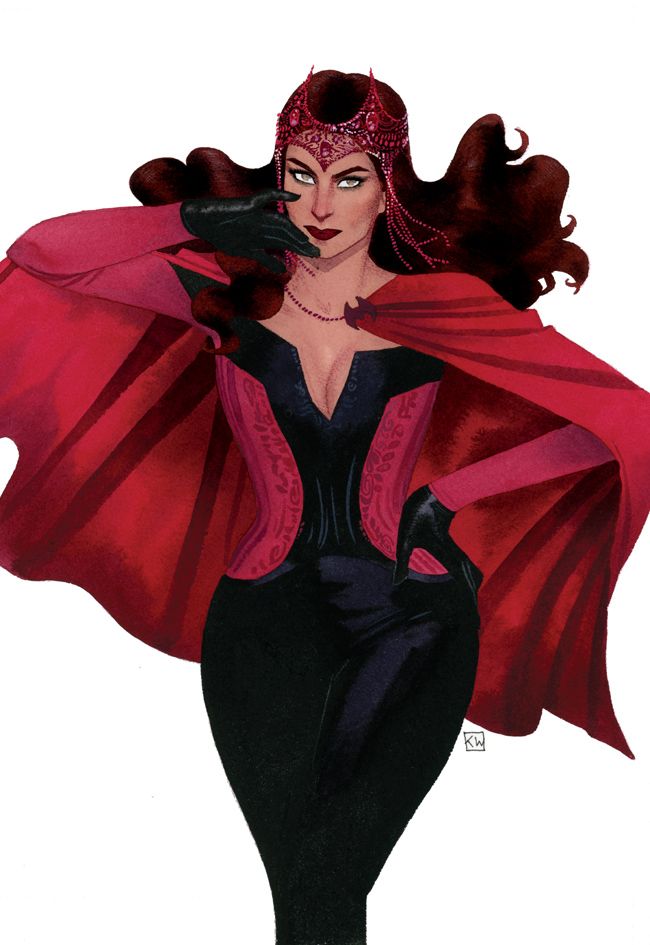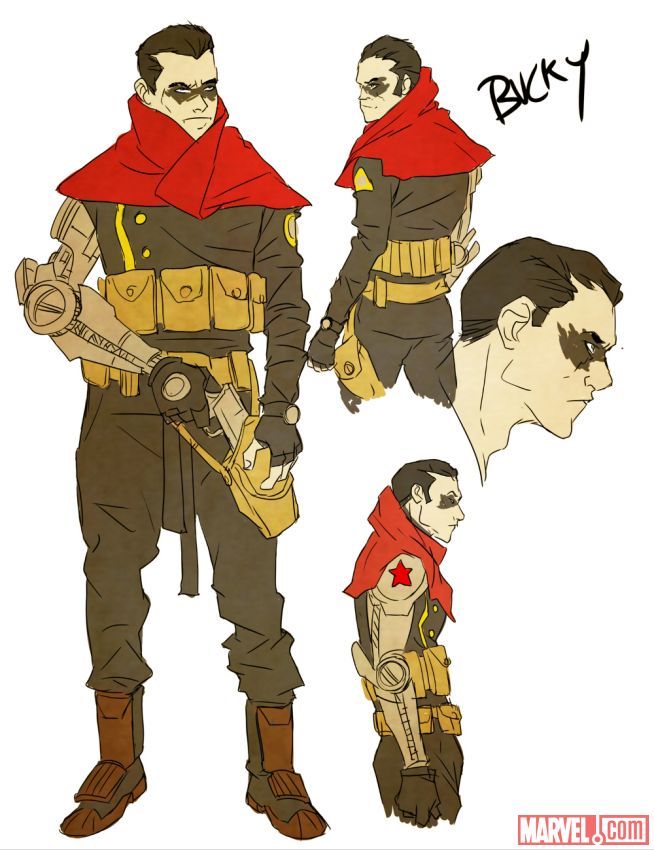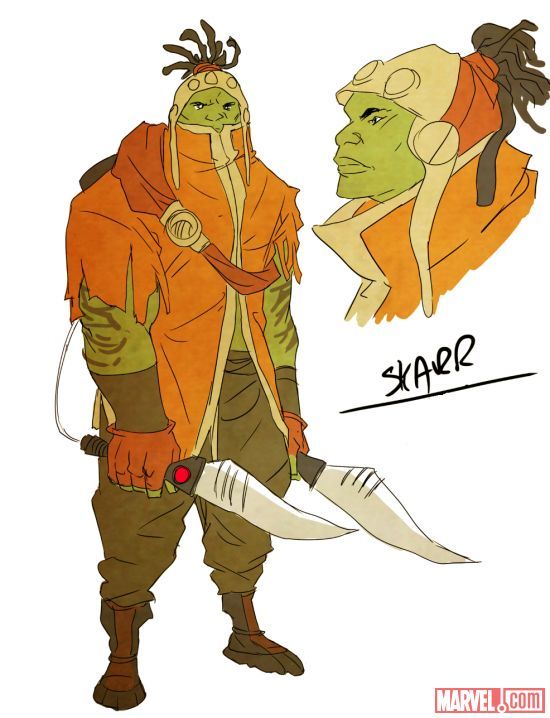Sanford Greene ("Runaways"), Felipe Smith ("All-New Ghost Rider"), Kevin Wada ("She-Hulk," various covers) and Kris Anka ("Uncanny X-Men") sat down to a packed room at Comic-Con International in San Diego, prepared to discuss the way they found themselves in comics and how they developed some of their iconic Marvel Comics designs.
"I've always been a fan of animation," Greene said. "I wasn't really knowledgeable that comics weren't really based in animation. As a kid, I thought, 'Wow, this stuff is awesome!' I almost had to unlearn the stuff that influenced me to begin with, because comics is more like art... A lot of my influences come from animation back in the day."
"I didn't read my first comic until I was 15 or 16 years old," Smith revealed. "My mother didn't buy me comics because she thought they were for stupid people. I did not see comics -- I saw storybooks. The first comics I saw were crazy violent, and they had sexual content... they were over the top... When I was kid, there was no Internet, so things didn't spread as quickly around the world... My first venture into comics was arguably a piece of garbage, called 'Cazador.' Obviously, my mom wasn't into that at all. I was totally into comics; it wasn't animation. Now, obviously, working on a kids show [character design for 'Teenage Mutant Ninja Turtles'], it's great. Our iteration of the Turtles is superior to what came before us, because we took the elements that were great and added to it. I learned to tone it down.
"I made Robbie Reyes, and... his Dodge Charger, which I think is the quintessential muscle car," he continued, discussin the main character from his recent "Ghost Rider" run. "Luckily, people responded! At first, they're like, 'This is garbage! And this is not even a human skull! Why does he have this metallic mask? What is this piece of explicit word?' Luckily, they gave it a shot, they read it... I had a chance to work with a bunch of artists. Now, Ghost Rider is in a car and people are cool with it and we have readers who were never into Ghost Rider before. We also have the lovely female demographic also following our story, which I am very hyped about because right now in comics, that's my percentage of the readership, which is very different from when I was growing up in the '90s. That's my roundabout origin story, that got me into animation and, at last, back into comics."
"I got into comics when I was 11, with a number one issue of 'Uncanny X-Men,'" Anka shared. "I never wanted to actually do comics. Through the luck of a coin toss, I went to college for animation. I put in an application because they didn't require the ACT or SAT. I did not want to take those. I applied for both graphic design and animation, and I got accepted to both, so I flipped a coin and went to animation school.
"I took a break after my third year to work at Sideshow as a concept designer and, in that time, I had gotten a contact at Marvel through people I worked with... and I applied there, because I always wanted to do covers, but I never actually wanted to draw pages... and didn't get it," he continued. "Then, about a few months later, Marvel emails me about wanting to hire me... I was going back to school, so I couldn't do comics for him at the time. So, as a consolation and just to keep me in his circle, he gave me covers for 'New Mutants' and then 'Age of Apocalypse.' At that point, I graduated college, and I started working on 'Ninja Turtles' with Felipe [Smith]... So I was working on 'Turtles,' doing storyboards in the beginning, which opened to designs and -- at that point -- Marvel had worn me down. It's been two years since they wore me down and I started doing pages for them. They'd keep enticing me, and eventually there was this ten-page short story... and I had three months to do it. So I took that, and I was doing a basically 9-to-9 day job in animation and then I was doing 9-to-4 on pages, and I did that for about six, seven months until I just couldn't juggle it anymore and Marvel wanted to hire me full time, so I switched over to do that."
"My background is in editorial illustration. Contrary to popular belief, I had not done any fashion illustration before," Wada said, drawing a surprised outcry from an audience member. "I was just doing my own personal fan art on the web, and somebody found me and I got an 'X-Men' variant cover... The editor I was working with really wanted to find an ongoing for me, and she found 'She-Hulk' and I did a nice round of issues and here I am."
Asked about his favorite classic character design, Greene responded, "This is my favorite character and also a pitch, if there are any Marvel editors in the panel right now, listen up: I must do the classic Power Man and Iron Fist. Everybody applaud for that! I must do that tiara on top of Luke Cage's head... and the chains of truth around his waist. I've got to do that. That character -- and of course Iron Fist -- those two guys, as a kid, that's what really got me. And, of course, I like Falcon and the Vision. It was something about the collar on the Vision. Doctor Strange had the same thing. The colors and everything were very pimp-like."
"I like Spider-Man," Smith said. "It stays pretty true, it's a simple, clean and very graphic design. It's strong, and red and blue work. The other thing about Spider-Man is that you don't know who he is. You don't know who's wearing that mask... As a kid, I found it really appealing. Here's another weird fact: as a kid, maybe three years old or whatever, I would take a sponge, and I would get it all sudsy with soap and stuff, and then I'd give myself the spiderwebs. I would make myself a Spider-Man suit! The thing that really got me about Spider-Man as a kid was the suit."
"It's classic Kirby Cap, because of those wings on the head," Anka said. "I like it because it's so utterly corny. It's so utterly perfect for what it is. To take an idea like that and wrap him in a flag costume is really awesome."
"My entrance into comics was Jim Lee 'X-Men,'" Wada said. "This is going to sound weird, but I really liked Anka's redesigns for Psylocke and Storm."
In response to a question about method, Wada added, "I think silhouette and color are the first things I think about... and then I try to sneak in as many fashion elements as I can get away with."
"I try to pick out what are the key elements of the character's design, and I try to make sure I don't get away from that, because that's part of who they are," Anka shared. "There's a lot of going back and forth in my head about... what to keep. With something like Spider-Woman, that one was difficult because there was so much background with that."
"I just realized, I've designed very few superheroes," Smith said. "All the comic book stuff I've done is people walking around in the streets doing stuff, wearing shoes, hoodies, hats... I think, when I create characters, I try to see how much of their personal character they can show through what they're wearing, or their hairdo, or just in the shape of their head and face and all those types of things."
"Everything he just said," Greene added.
The four artists then went through each of their iconic designs, starting with Smith's Ghost Rider and continuing with Anka's Captain Marvel, Wada's Scarlet Witch and Greene's host of teenage characters from "Runaways."
"The design came first," Smith said. "Probably right off the bat, I had an idea of what he would look like. It's based on what I saw in LA. The first thing I wanted to do with the story was move the book from the East coast to the West coast... The elements came from looking at teenagers on the [Universal] Citywalk.
"The thing about the [blonde] lock of hair is that it wasn't just a choice, like, 'Hey, that's aesthetically pleasing, that's hot.' The whole thing is, he's a new character that nobody knows, and that's foreshadowing of who he was," he continued. "He's Latino and he's Mexican-American. I wanted that to be clear. I wanted his background to be evident visually as well... I felt like he needed something else, that he needed a highlight or something that gave him character, that made him stand out from an army of kids with black hair that look just like him. I thought of the flame, and that would really foreshadow what he'd turn into eventually, but also gave him a little bit of character... A lot of kids his age choose to shave their heads and wear a lot of white T-shirts. I did a lot of research. I like designs to be grounded in reality, and the coolest thing about that, once in a while, you get a reader who identifies completely with that character, or at least know somebody who is exactly like that character.
"I gave him a muscle car instead of a motorcycle. A lot of people were like, 'Oh! Mexican kid on the East Side of LA, of course he would have a '74 Impala.' I really wanted to avoid that because I didn't want to make him a walking cliche. Part of making a character is going against the grain, being a little different, so the jacket, the hoodie, the skinny jeans... you walk into a neighborhood, you immediately want to beat this guy's ass. I thought that would give Robbie an edge, character-wise. It definitely gives him character before he says a single word... The spirit of Eli is not actually a Spirit of Vengeance, so Robbie is technically not a Ghost Rider. It's part of Robbie that he's not actually a Ghost Rider."
"That was my first real pass at his transformed version," Smith continued, referring to the character design sheet on the screen. "Then Tradd Moore, the artist for the first part of the series, we went back and forth, and we sent the final you see at the bottom... His head, that's not a helmet. Oh, I read the Internet... I get on there, and then I just curse people, but I don't make the mistake of doing it on the Internet... I just read and I take notes and I see what makes sense and what doesn't... Basically, I wanted him to not be another skull and flames. He had to be all-new. It was a haunted car that he steals for race to try to get out of the neighborhood, 'Fast and the Furious' style, but that didn't happen and he gets killed, and then the spirit inside of the car gets inside him. He doesn't have a human skull. He's not a Spirit of Vengeance. He's actually the spirit of a serial killer who was a Satanist and ends up being something else.
"[Robbie] has a blower on his forehead and vents on the back of his head and the lines of the helmet mimic the lines of the Dodge Charger," he explained. "If you look at his jaw, it looks like a bumper in the front of a car. The round hole in his forehead is like the blower on the hood, and then the vents in the back actually mimic the exhaust pipes of the Dodge Charger... It had to look like a helmet but it had to be proportions of a human head."
Greene took the mic next, saying, "You guys are familiar with Bucky, in terms of the mechanical arm... Basically, in the 'Runaways' story we're doing now, we wanted to play with some of these elements that are known in the 616 and reverse some things. You know, Bucky's left arm is the mechanical arm. In that ['Runaways'] world, it's his right arm. We wanted to play with it a little bit more in terms of making it look a little more mechanical. There's a little more gears and gadgets that protrude from the arm."
Bucky isn't Greene's only redesign for "Runaways" as he's tackled characters from Jubilee to Amadeus Cho to Skaar. Of these characters, Greene said, "I'm a lover of urban culture, especially in the fashion sense, and I wanted to play with a lot of those elements and bring them into our characters... You see these characters, and you see that they look like kids could be wearing these things. Overall, I kept it very simple, with the exception of Skaar. I wanted to bring a little more African tribal culture with him. I felt, just from the 616 universe, he had that feel already. He's a warrior. I wanted to take that a little further, and he is a little younger in Battleworld... Ms. Marvel, she is who she is. She's young, she's spry and fiery. I wanted to play with those colors a little bit. Amadeus Cho is probably the most grounded. I mean, he wears anything that Kris Anka would wear... You'll notice Dagger is very different. She's not wearing the form fitting outfits; it's very baggy and loose. She's got that insecure look to her. Again, we totally wanted to reverse her character. We took Cloak and Dagger's powers and we reversed them in this story. Dagger is doing more of what Cloak would do; she has more life force than dark force... Overall, that was the whole concept behind this."
"So this is the first model I had done," Anka said as his Captain Marvel design appeared on screen. "When they asked me to join the book, one of the weird stipulations I had was that I wanted to redesign Carol. Not so much that I didn't like the costume... Carol's costume is already pretty damn perfect, so it was pretty much all minor things I wanted to add to make it much more my own.
"I got into comics when she was Warbird, and the Warbird costume was super armored, not flashy in any way," he continued. "I kind of wanted to bring some of that toughness back... She's not so much an Avenger anymore; she has a higher role, so I wanted the costume to feel a bit more sci-fi and a bit more tough. The first thing I changed was the boots... Obviously, barely anything has changed; they [the editors] were pretty cool with it... The colors are the same. One of the other changes is to the sash. We made it look more useful. It's one of those things at Marvel; all those designs kind of look useful in some way, or at least they try to. They went overboard with pouches at one point... There's a use for every single pouch I put on her. We changed the normal sash to a belt, but I wanted to keep the sash on the belt because that's a really great look... It makes her stand out.
"The other big change was the hair, because... there was a lot of confusion on what her actual hair was. Jamie [McKelvie] did that sort of shoulder-length bob, then there was the butch hair cut, there was a weird in-between one, like a fauxhawk... It was like that because no one actually knew what the haircut was. If you ask Kelly [Sue DeConnick], she wanted the long hair, so there was all this confusion about it. When we wanted to do this, we wanted to make a specific haircut and, since she was changing what her job was, we wanted to make her have a fresh start... I preferred sort of the butch hair cut. I imagined it shorter than it was originally, kind of like Charlize Theron."
After saying that this is his first official redesign, Wada spoke a little about how he tackled the Scarlet Witch. "I'm really nervous about this one. The main change, which is one of the most controversial changes, was reinventing the headpiece... I never really loved the headpiece, though some artists can render it in a really beautiful way... The main task was how do you redesign the headpiece? I was like, 'Let's go modern witch coven fashion,' like lots of lace and sheers and things, so we eventually redesigned the headpiece as jewelry, with some beads... I hope people like it! I hope you know that it's not all me, it's also the editors! I don't know officially, but some of those [other various] designs will make it into the book as well. She'll have a few costumes."
After that, there was only time for one more question. A member of the audience approached the mic and asked how the four artists deal with the functionality of their redesigns.
"I draw it, and I act it out real quick," Greene answered.
"I don't like functional," Anka shared. "I think it's a really steep cliff that makes people forget that this is superheroes and this is outlandish... That loses a lot of the fun of it. Some function is good... but some characters, like Cable, shouldn't be functional. It can't apply to everybody. It needs to be about character rather than function."
"I think if it distracts you, then there's something wrong there, or if you can tell immediately what everything is doing, that's also kind of boring," Smith weighed in. "You've got to strike a balance. You've got to have some functionality that is obvious, then a little bit of mystery in your design."

